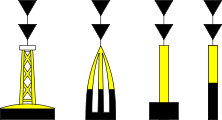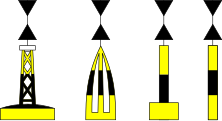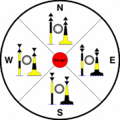Cardinal system
The cardinal system (from cardinalis (Latin) = "important, excellent") is used in shipping to designate a system for marking obstacles or shoals by means of directional navigation marks . Barrels (also called shallow bins, cardinal bins, wreck bins or danger bins), beacons or simple bars are used.
The marking of fairways with side buoys is based on the lateral system .
The area around the obstacle is divided into four quadrants, each corresponding to a direction . The respective quadrant is marked by a cardinal buoy, whose marking indicates where it is relative to the obstacle and on which side it is to be avoided. In practice it should be noted that not all four quadrants have to be labeled. Usually only one of the quadrants is marked. For example, a shoal off the coast and connected to the coast is only indicated on the outside with a cardinal sign.
Design and lighting
Cardinal nautical marks have two cones as top marks and are horizontally striped in black and yellow. Cardinal barrels can carry a white twinkling fire with 60 flashes per minute (abbreviation: Q “quick”) or a fast twinkling fire with 120 flashes per minute (abbreviation: VQ “very quick”). The light intervals also indicate the quadrant. The identification of the bucket in the north quadrant is an uninterrupted twinkling fire; the light signs of the barrels in the remaining quadrants correspond to the digits on a clock. An additional blink is added to the identifier for the south quadrant. For better differentiation, obstacles lying close together are alternately fired with Q or VQ.
The tips of the top mark of the bin and the body of the bin marked with black and yellow paint indicate where the bin is in relation to the danger point.
Fire cardinal sign
- North: black-yellow; both cones point upwards (quasi to the north), uninterrupted sparkling light
- East: black-yellow-black; both cones are with the base to each other (optically like the letter "O" for east), groups of 3 lightning bolts
- South: yellow-black; both cones point downwards (almost to the south), groups of 6 flashes and one flash
- Vests: yellow-black-yellow; both cones point to each other (optically like the letter “W” rotated by 90 ° for west), groups of 9 flashes.
The cones and colors correspond in such a way that the cones point in the direction of the black (upwards, outwards, downwards or inwards).
In the case of new danger spots, according to the Maritime Traffic Regulations, "due to special circumstances, at least one visual signal can be duplicated and possibly with a radar beacon with the identifier 'D'."
Eastern Cardinal Barrel in British Columbia
Western cardinal sign in front of Marseille
Single hazard sign
The individual danger sign is not a cardinal sign, but also designates a danger point. It is marked with two black balls as a top sign, groups of two blinks (if fired) and one or internationally also several horizontal red stripes.
Web links
Individual evidence
- ↑ Appendix I of the SeeSchStrO , Section I "Visual signals", No. B.15 "Hazardous areas"
- ↑ Appendix I of the SeeSchStrO, Section I “Visual signals”, No. B.15 f) “New danger areas”
- ↑ International Association of Lighthouse Authorities : Maritime Bouyage System (PDF, 2.69 MB), p. 6, accessed on February 9, 2016














